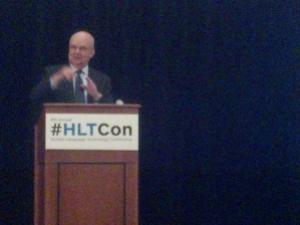Gen. Michael Hayden, former CIA and NSA director, keynoted this year’s Basis Technology Human Language Technology Conference. Basis develops natural language processing software that is applied for search, text analytics for a broad set of industries, and investigations. That a text technology provider would recruit an intelligence leader speaker is no mystery: Automated text understanding, and insight synthesis across diverse sources, is an essential capability in a big data world. And Hayden’s interest? He now works as a principal at the Chertoff Group, an advisory consultancy that, like all firms of the type (including mine, in data analysis technologies) focuses on understanding and interpreting trends and shaping reactions and on maintaining visibility by communicating its worldview.

Data, insights, and applications were key points in Hayden’s talk. (I’m live-blogging from there now.)
I’ll provide a quick synopsis of six key trend points with a bit of interpretation. The points are Hayden’s — applying to intelligence — and the interpretation is generally mine, offered given broad applicability that I see to a spectrum of information-driven industries. Quotations are as accurate as possible but they’re not guaranteed verbatim.
Emergent points, per Michael Hayden:
1) The paradox of volume versus scarcity. Data is plentiful. Information, insights, are not.
2) State versus non-state players. A truism here: In the old order, adversaries (and assets?) were (primarily) larger, coherent entities. Today, we live and operate, I’d say, in a new world disorder.
3) Classified versus unclassified. Hayden’s point: Intelligence is no longer (primarily) about secrets, about clandestine arts. Open source (information, not software) is ascendant. Hayden channels an intelligence analyst who might ask, “How do I create wisdom with information that need not be stolen?”
4) Strategic versus specific. “Our energy is now focuses on targeting — targeted data collection and direct action.” Techniques and technologies now focus on disambiguation, that is, to create clarity.
5) Humans versus machines. Hayden does not foresee a day (soon?) when a “carbon-based machine” will not be calling the shots, informed by the work of machines.
6) The division of labor between public and private, between “blue and green.” “There’s a lot of true intelligence work going on in the private sector,” Hayden said. And difficulties are “dwarfed by the advantage that the American computing industry gives us.”
Of course, there’s more, or there would be were Hayden free to talk about certain other trend points he alluded to. Interpreting: Further, the dynamics of the intelligence world can not be satisfyingly reduced to bullet trend points, whether the quantity is a half dozen or some other number. The same is true for any information-driven industry. Yet data reduction is essential, whether you’re dealing with big data or with decision making from a set of over-lapping and potentially conflicting signals. All forms of authoritative guidance are welcome.